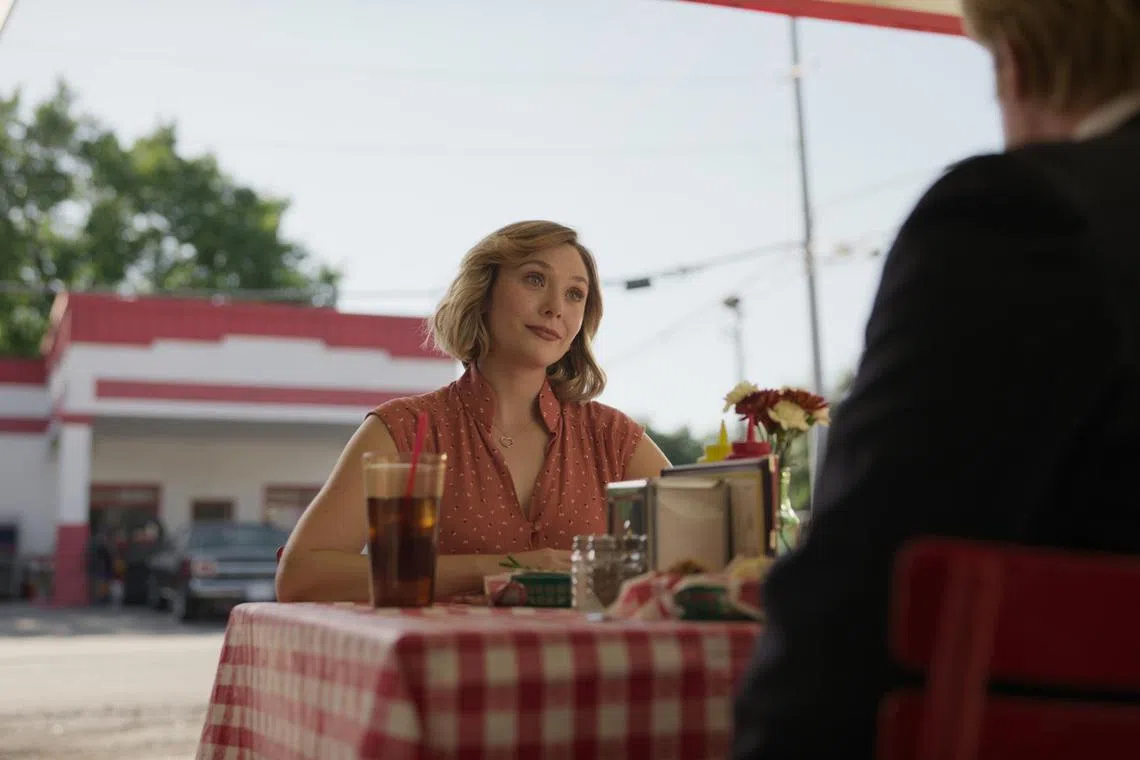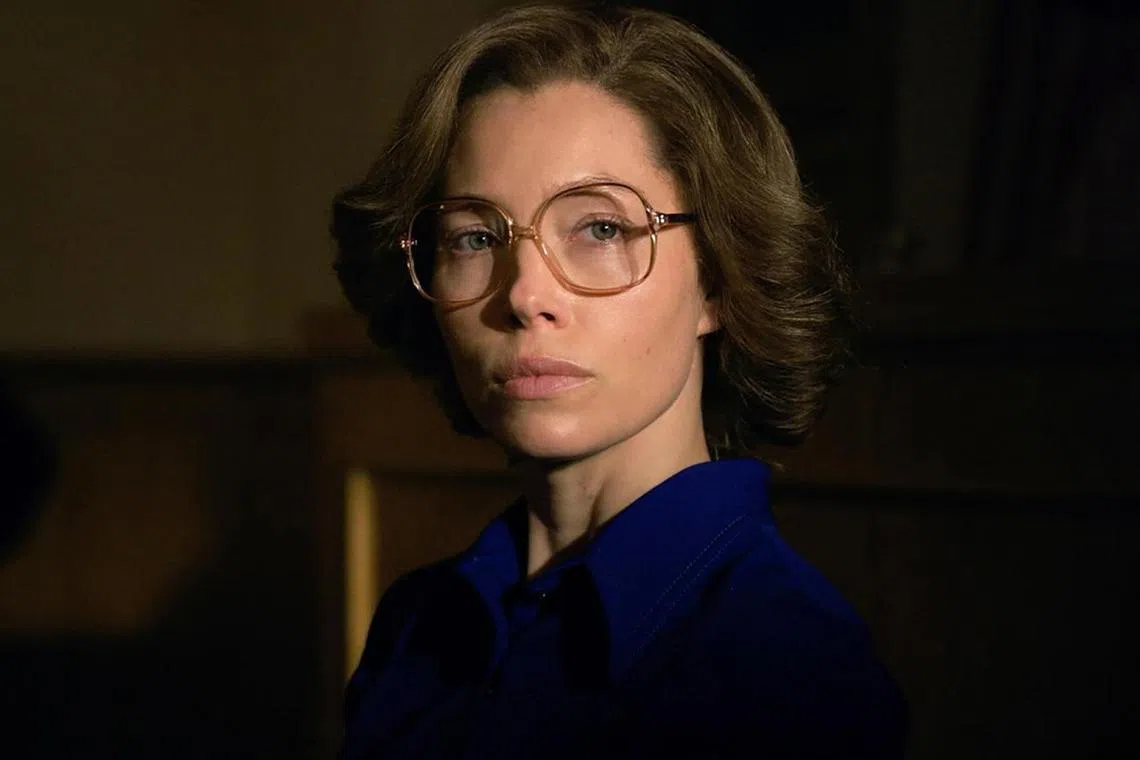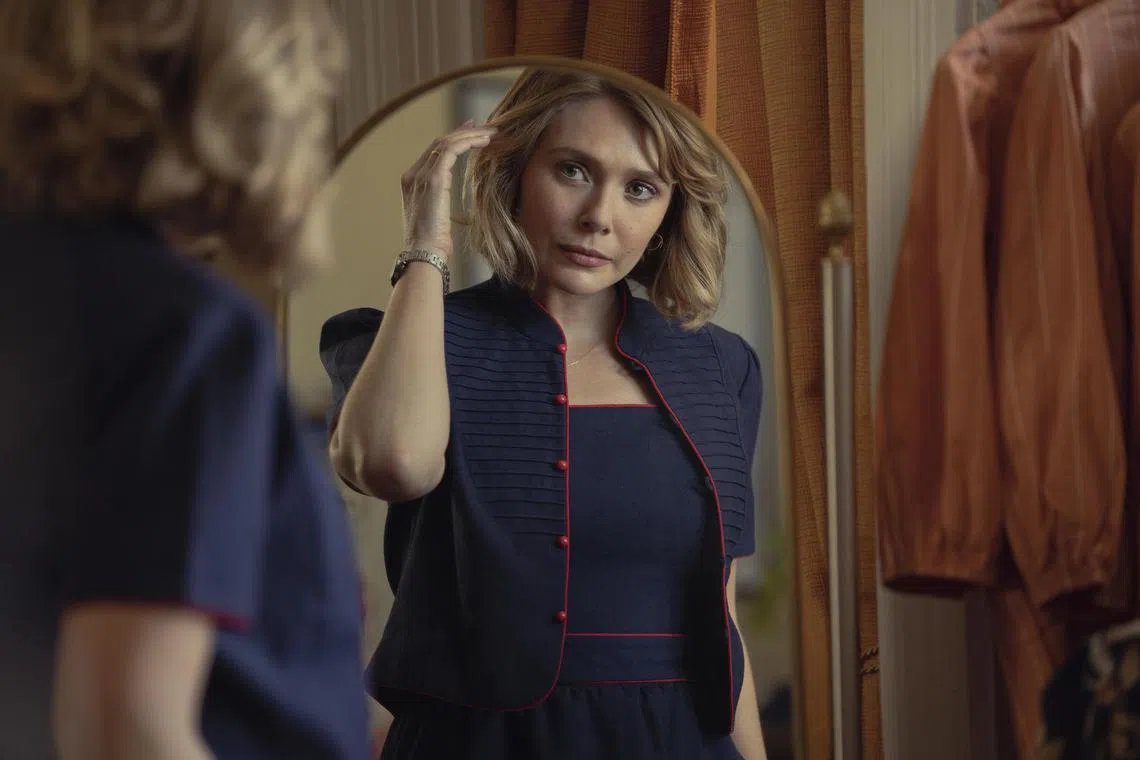Love & Death, Candy and the feminine urge to commit murder
Sign up now: Get ST's newsletters delivered to your inbox

Actress Elizabeth Olsen stars in Love & Death, a fictional retelling of a true-crime case.
PHOTO: HBO GO
Follow topic:
NEW YORK – On June 13, 1980, Candy Montgomery, a housewife and mother of two in a North Texas exurb, dropped her two children and one of their friends at church, picked them up for swimming lessons and then took them to see the Star Wars film, The Empire Strikes Back (1980).
At some point in the late morning, she also killed Betty Gore, the mother of that friend, striking her with an axe 41 times in the utility room of the Gore home.
That slaying and Montgomery’s eventual acquittal (she claimed self-defence; the jury believed her) have inspired two miniseries more than 40 years later: Candy, which aired on Disney+ in 2022, and Love & Death, now available on HBO Go.
These shows join a recent crop of fact-based dramas about women who kill or who kill by proxy – The Act (2019), The Landscapers (2021), The Girl From Plainville (2022) and The Thing About Pam (2022).
Women who resemble the protagonists of these series, white and most often middle-class, are already familiar archetypes of the true-crime mythos: the mothers always ready with a kind word and a casserole, the daughters with smiles that light up a room, the women with their whole lives ahead of them.
But in most true-crime narratives, these mothers, daughters and wives are the victims.
Here, they are the killers. This grants these series, which typically attract a majority female audience, a unique appeal and horror. Murderers: They are just like us.
“It is scary,” Jessica Biel, who played the title role in Candy, agreed in a recent telephone conversation.
The 41-year-old American actress spoke of Montgomery’s service within her community and her care for her children. If a woman like Montgomery could commit murder, maybe any woman could.
“If she can do that, I guess I’m capable of doing that,” she said. “Everybody’s capable. That’s the thing that’s terrifying... and fascinating.”

Jessica Biel played the title role in Candy.
PHOTO: DISNEY+
In the United States, female killers are comparatively rare. And despite the narratives that true crime prefers, female victims are too.
Half a decade ago, the Federal Bureau of Investigation calculated that more than 88 per cent of the perpetrators of homicides were men and that women comprised just over 21 per cent of homicide victims. And yet polls suggest that women seek out true-crime media – books, podcasts, dramas, documentaries – more frequently than men, particularly media about violent crime.
There are two main theories to explain this feminine obsession, which some researchers have termed a “fear of crime” paradox, in that women are much more likely to be compelled by what is far less likely to affect them.
The first, said professor of psychology Marissa Harrison at Penn State Harrisburg and author of Just As Deadly: The Psychology Of Female Serial Killers (2023), involves thrill-seeking and morbid curiosity – the same impulse that makes people rubberneck at a car crash.
Harrison also sketched out the second theory, which is that women consume true crime out of protective vigilance.
“We evolved over time to pay attention to the things that could harm us,” she said.
Dramas about the likes of Jeffrey Dahmer, Ted Bundy or Richard Ramirez never worry too much about the why of it all, intent on establishing monstrosity rather than delving for a root cause.
Where women are concerned, however, the why is paramount, with viewers asked to play close attention to the killer’s circumstances, behaviours and psychology.
“When instead of being caregiving and loving, she’s harmful and hurting and murdering. It’s ‘Why? Why? Why?’” Harrison said.
The why attracted David E. Kelley, the American writer of Love & Death, to the Montgomery case.
“Therein lies the mystery,” he said. “How could a person who had great aspirations in her heart, including love and community, act in a way that belied those principles at their deepest core?”
Both Candy and Love & Death solve this mystery by accepting and reiterating Montgomery’s version of events.
On the stand, she testified that Gore had attacked her first, angry over an affair that Montgomery had had with Gore’s husband Allan.
A psychotherapist also offered evidence, obtained under hypnosis, of childhood trauma that Montgomery had suffered.
The defence’s theory held that when Gore shushed Montgomery during the attack, it recalled that trauma, pushing Montgomery into a dissociative state.
But the why is not the whole of the story. Any true-crime drama worth its blood spatter has to show the how.
Since both Candy and Love & Death are identified as prestige drama rather than true-crime drama, however fact-based, both shows struggled with how much violence to show and from whose point of view.
Robin Veith, a creator of Candy, said: “We wrestled every moment of every day of whether we should actually shoot the killing.”
Both shows ultimately staged the death in ways that also dovetailed with Montgomery’s trial testimony, in scenes that disturbed even the people making them.
Murder, even imagined murder, exacted a toll.
Biel described taking refuge in the period-appropriate set decoration and costumes of Candy, particularly the wigs. Only by immersing herself fully in the character, from the toes of her sandals to the ends of her curls, could she allow herself to feel what Montgomery had presumably felt, to do what she had done.
“The second I put that wig on, I didn’t recognise myself,” she said. “I could behave in a way that I wasn’t accountable for.”
American actress Elizabeth Olsen, star of Love & Death, had fewer wigs to rely on.

Elizabeth Olsen in Love & Death.
PHOTO: HBO GO
On-screen, she looks less like the real Montgomery. Her Candy – a mingling of soft voice and hard angles, dream and determination – is arguably more impressionistic.
The first time she shot the killing sequence, she found herself hyperventilating, sick with adrenaline.
“I don’t like violence at all,” said the 34-year-old during a video call. “It was a horrible feeling. There was no part of me that entertained, ‘Oh, I wonder what that would feel like to play.’ It was really nasty.”
Lesli Linka Glatter, the veteran director who shot Love & Death, wept after calling, “Cut”.
“Have I ever cried on a set? Never,” she said. “This was probably one of the most upsetting things I’ve ever shot, because it was real, because it was up close and personal. It was just two women, two housewives in this room.”
Two housewives went into that utility room, but only Montgomery walked out. And while most people will want to tell themselves that killers are different from the rest of them, a woman like Montgomery – so personable, so ladylike – thwarts that disidentification.
“Maybe the most frightening thing is that monsters could lie within us all, even the people that we love and trust,” Kelley said. NYTIMES
Love & Death is showing on HBO Go.

